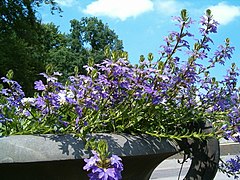Difference between revisions of "Scaevola aemula"
(Created page with '{{SPlantbox |familia=Goodeniaceae |genus=Scaevola |species=aemula |habit=herbaceous |habit_ref=Flora - A Gardener's Encyclopedia |Max ht box=6 |Max ht metric=in |height_ref=Flor…') |
|||
| Line 1: | Line 1: | ||
{{SPlantbox | {{SPlantbox | ||
|familia=Goodeniaceae | |familia=Goodeniaceae | ||
| − | |genus=Scaevola | + | |genus=Scaevola |
|species=aemula | |species=aemula | ||
| + | |taxo_author=R.Br. | ||
| + | |common_name=Fairy Fan-flower | ||
|habit=herbaceous | |habit=herbaceous | ||
|habit_ref=Flora - A Gardener's Encyclopedia | |habit_ref=Flora - A Gardener's Encyclopedia | ||
| Line 23: | Line 25: | ||
|usda_ref=Flora - A Gardener's Encyclopedia | |usda_ref=Flora - A Gardener's Encyclopedia | ||
|max_zone=11 | |max_zone=11 | ||
| − | |image= | + | |image=Scaevola amuela ParkSanssousi 100706b.JPG |
|image_width=240 | |image_width=240 | ||
| + | |image_caption=Fairy Fan-flower | ||
}} | }} | ||
| − | + | '''''Scaevola aemula''''' ('''Fairy Fan-flower''' or '''Common Fan-flower''') is a small shrub in the family [[Goodeniaceae]], native to southern [[Australia]]. It grows to 50 cm in height and produces white or blue flowers in spikes up to 24 cm long from August to March in its native range.<ref name=FOA>Flora of Australia Online</ref> These are followed by rounded, wrinkled berries to 4.5 mm in length.<ref name=NSW>http://plantnet.rbgsyd.nsw.gov.au/cgi-bin/NSWfl.pl?page=nswfl&lvl=sp&name=Scaevola~aemula</ref> | |
| + | |||
| + | The species occurs in [[Western Australia]]<ref name=WA>{{FloraBase|name=''Scaevola aemula'' |id=7594 }}</ref>, [[South Australia]]<ref name=SA>http://www.flora.sa.gov.au/cgi-bin/texhtml.cgi?form=speciesfacts&family=Goodeniaceae&genus=Scaevola&species=aemula</ref>, [[Victoria (Australia)|Victoria]]<ref name=NSW/> and [[New South Wales]].<ref name=NSW/> | ||
| + | |||
| + | The species is thought to be the most commonly cultivated of the genus ''[[Scaevola]]'', and a large number of cultivars have been developed.<ref name=ASGAP>http://asgap.org.au/s-aem.html</ref><ref name=Seale>Garden Companion to Native Plants, Reed Books, ISBN 0730101878</ref> | ||
| + | Most of these are mat-forming to a height of 12 cm and spreading up to 1 metre in width. It prefers a sunny or partially shaded, well-drained position and tolerates salt spray and periods of drought.<ref name=Seale/> Pruning and pinching of tip growth may be carried out to shape the plant.<ref name=Seale/> Propagation is from [[Cutting (plant)|cuttings]] or by [[layering]].<ref name=Seale/> | ||
==Cultivation== | ==Cultivation== | ||
Latest revision as of 00:48, 21 May 2010
| Habit | herbaceous
| |
|---|---|---|
| Height: | ⇕ | 6 in"in" can not be assigned to a declared number type with value 6. |
| Width: | ⇔ | 20 in"in" can not be assigned to a declared number type with value 20. |
| Lifespan: | ⌛ | perennial |
| Bloom: | ❀ | early spring, mid spring, late spring, early summer, mid summer, late summer, early fall, mid fall, late fall, early winter, mid winter, late winter |
| Exposure: | ☼ | sun |
|---|---|---|
| Features: | ✓ | flowers |
| USDA Zones: | 9 to 11 | |
| Flower features: | ❀ | red, blue, purple, pink |
|
Scaevola > |
aemula > |
R.Br. > |
Scaevola aemula (Fairy Fan-flower or Common Fan-flower) is a small shrub in the family Goodeniaceae, native to southern Australia. It grows to 50 cm in height and produces white or blue flowers in spikes up to 24 cm long from August to March in its native range.[1] These are followed by rounded, wrinkled berries to 4.5 mm in length.[2]
The species occurs in Western Australia[3], South Australia[4], Victoria[2] and New South Wales.[2]
The species is thought to be the most commonly cultivated of the genus Scaevola, and a large number of cultivars have been developed.[5][6] Most of these are mat-forming to a height of 12 cm and spreading up to 1 metre in width. It prefers a sunny or partially shaded, well-drained position and tolerates salt spray and periods of drought.[6] Pruning and pinching of tip growth may be carried out to shape the plant.[6] Propagation is from cuttings or by layering.[6]
Cultivation
Propagation
Pests and diseases
Varieties
Gallery
References
- ↑ Flora of Australia Online
- ↑ 2.0 2.1 2.2 http://plantnet.rbgsyd.nsw.gov.au/cgi-bin/NSWfl.pl?page=nswfl&lvl=sp&name=Scaevola~aemula
- ↑ Template:FloraBase
- ↑ http://www.flora.sa.gov.au/cgi-bin/texhtml.cgi?form=speciesfacts&family=Goodeniaceae&genus=Scaevola&species=aemula
- ↑ http://asgap.org.au/s-aem.html
- ↑ 6.0 6.1 6.2 6.3 Garden Companion to Native Plants, Reed Books, ISBN 0730101878
External links
- w:Scaevola aemula. Some of the material on this page may be from Wikipedia, under the Creative Commons license.
- Scaevola aemula QR Code (Size 50, 100, 200, 500)

